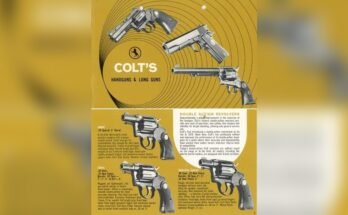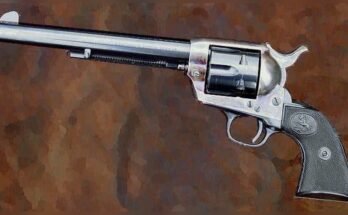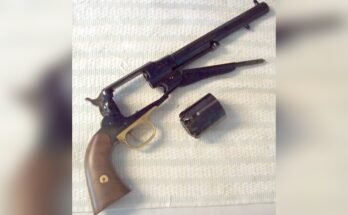Are you thinking about getting your first revolver but not sure if a single-action model is right for you? Choosing the perfect firearm as a beginner can feel overwhelming.
You want something reliable, easy to use, and safe. A single-action revolver might seem old-fashioned, but it has unique features that could make your shooting experience both fun and rewarding. Keep reading to discover if this classic firearm fits your needs and how it could help you build confidence from your very first shot.
Single-action Revolver Basics
Single-action revolvers have a long history and a simple design. They are often seen as classic firearms with a straightforward mechanism. Understanding their basics helps beginners decide if this type suits their needs. The simplicity and style attract many new shooters.
How It Works
A single-action revolver requires the shooter to manually cock the hammer before each shot. Pulling the hammer back spins the cylinder to the next round. Then, pulling the trigger releases the hammer to fire the bullet. This process repeats for every shot fired.
This design means the trigger only performs one action: releasing the hammer. It makes the trigger pull lighter and smoother than double-action revolvers. The shooter controls the timing of each shot by cocking the hammer.
Key Features
Single-action revolvers have fewer moving parts, making them easier to clean and maintain. Their triggers are usually crisp and light, which can improve shooting accuracy. Many models have a classic look with wooden grips and a simple frame.
They usually hold between five to six rounds. Reloading is slower compared to modern firearms but offers a tactile experience. The manual cocking also adds to the safety, as the gun won’t fire unless the hammer is pulled back.

Pros For Beginners
Single-action revolvers offer many benefits for those new to shooting. Their design and function make learning easier and safer. Beginners can gain confidence quickly by using these firearms.
Understanding the pros helps new shooters choose the right gun. Here are some key advantages of single-action revolvers for beginners.
Simplicity And Reliability
Single-action revolvers have a simple mechanism. You cock the hammer before each shot. This clear process reduces confusion for beginners.
Fewer moving parts mean fewer things can go wrong. This makes the revolver very reliable. It works well in many conditions without jamming.
Safety Advantages
The design of single-action revolvers helps prevent accidental firing. The hammer must be manually cocked before shooting. This extra step adds a layer of safety.
Beginners can take time to aim and prepare. This reduces the chance of careless shots. The clear steps make safe handling easier to learn.
Ease Of Maintenance
Single-action revolvers are easy to clean and maintain. Their simple design means fewer parts to worry about. Beginners can quickly learn basic care routines.
Good maintenance keeps the gun working smoothly. This builds trust and confidence in handling the firearm.
Cons For Beginners
Single-action revolvers have some drawbacks for beginners. These cons can affect learning and shooting experience. Understanding these points helps new shooters decide if this firearm suits them.
Learning The Cocking Mechanism
Single-action revolvers need manual cocking before each shot. This step can be tricky for new shooters. It requires practice to do smoothly and safely. Missing this step means the gun won’t fire. This extra action can slow down the shooting process.
Slower Firing Rate
The firing rate is slower compared to other guns. Each shot needs the hammer to be cocked manually. This slows down quick shooting or self-defense situations. Beginners might find this frustrating during practice or stress.
Limited Capacity
Single-action revolvers usually hold fewer rounds. Most models carry five or six bullets. This means more frequent reloading is necessary. Beginners may find this inconvenient during shooting sessions. It limits how long they can shoot without stopping.

Comparing To Other Firearms
Choosing the right firearm for beginners means understanding different types. Each type works differently and suits different needs. Comparing single-action revolvers to other firearms helps decide what fits best. This section breaks down key differences clearly.
Single-action Vs Double-action Revolvers
Single-action revolvers require the shooter to manually cock the hammer before each shot. This action makes shooting slower but more controlled. Double-action revolvers let you pull the trigger to both cock and fire. This makes double-action faster and easier for quick shots.
For beginners, single-action revolvers teach careful shooting habits. Double-action revolvers allow faster shooting but need more trigger control. Both have simple designs but different handling styles.
Single-action Vs Semi-automatic Pistols
Semi-automatic pistols use magazines and fire multiple rounds quickly. Single-action revolvers hold fewer rounds and need manual cocking. Pistols reload faster but require more maintenance and skill.
Single-action revolvers have fewer moving parts and are easier to clean. Semi-automatic pistols offer higher capacity and quicker follow-up shots. Beginners may find revolvers simpler but pistols more practical for self-defense.
Expert Tips For New Shooters
Starting with a single-action revolver can be exciting yet challenging. New shooters need clear guidance to build confidence and skills. Expert tips help beginners handle these firearms safely and effectively. Below are important points to consider for training, choosing the right revolver, and practicing safety.
Training Recommendations
Begin with basic firearm safety courses. Learn how to load, unload, and handle the revolver carefully. Practice dry firing to understand the trigger pull without live rounds. Spend time at the range with an experienced instructor. Focus on aiming, grip, and trigger control. Regular practice builds muscle memory and improves accuracy. Start slow, then increase speed as confidence grows.
Choosing The Right Model
Select a revolver with a comfortable grip for your hand size. Lighter models are easier to hold and control. Look for a revolver with a smooth trigger pull. A smaller caliber, like .22 or .38, reduces recoil and helps beginners learn safely. Avoid complicated designs that can confuse new shooters. Test different models at a local store or range. Pick one that feels steady and balanced.
Safety Practices
Always treat the revolver as if it is loaded. Keep your finger off the trigger until ready to shoot. Point the firearm in a safe direction at all times. Wear eye and ear protection during practice sessions. Store the revolver securely, away from children and unauthorized users. Understand how to clear jams or misfires safely. Follow all local laws and regulations for firearm use.
Popular Single-action Revolvers For Beginners
Single-action revolvers offer a classic shooting experience. They are simple and reliable. Many beginners find them easy to use and maintain. Learning to shoot with a single-action revolver helps build strong fundamentals. The slower pace encourages careful aiming and control. Here are some popular models that suit beginners well.
Top Models To Consider
The Colt Single Action Army is a famous choice. It has a strong history and solid build. Ruger Vaquero is another good option. It offers modern features with a classic look. The Smith & Wesson Model 686 is a versatile revolver. It combines ease of use with good accuracy. Each of these models suits beginners in different ways.
Price And Availability
Single-action revolvers come in various price ranges. Colt models tend to be more expensive. Ruger and Smith & Wesson offer affordable options. Many gun stores stock these revolvers regularly. Online shops also provide easy access. Prices usually range from $500 to $1,200. Budget and preferences will guide your choice.

Frequently Asked Questions
Is A Single-action Revolver Easy For Beginners To Use?
Yes, single-action revolvers are straightforward with simple mechanics. Beginners can learn trigger control and aiming effectively with practice.
What Makes Single-action Revolvers Safe For New Shooters?
Single-action revolvers require manual cocking before each shot, preventing accidental firing. This feature adds a safety layer for beginners.
Are Single-action Revolvers Suitable For Self-defense Beginners?
Single-action revolvers work, but slower firing speed may be a drawback. Beginners should consider their comfort and training before choosing.
How Does Single-action Revolver Maintenance Benefit Beginners?
Single-action revolvers have fewer moving parts, making cleaning easier. This simplicity helps beginners maintain their firearms properly and safely.
Conclusion
A single-action revolver can be a good choice for beginners. It offers simplicity and easy handling. Learning how to load and shoot builds solid skills. The slower firing pace helps with safety and control. Some may find the trigger pull light and predictable.
Practice is key to gaining confidence and accuracy. Choose a revolver that feels comfortable in your hand. Remember, patience and careful learning make all the difference. This type of gun suits those who want a straightforward start.


